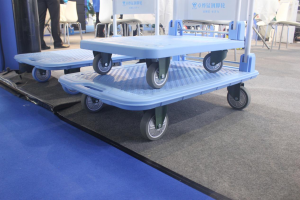Abstract: Trolleys are a common handling tool and the choice of the number of universal wheels in their design is critical to their balance and maneuverability. This paper will look at how many gimbals are typically used on hand trucks and the reasons why they are designed this way.
Introduction:
A handcart is a convenient tool widely used in logistics, warehousing and household applications. It is capable of carrying heavy loads and moving them by human power, so its design needs to consider balance, maneuverability and stability. Among them, the universal wheel is one of the important components in the design of the cart, which can affect the performance of the whole vehicle. Carts usually use two universal wheels. This is designed to provide the best balance between balance and maneuverability.
Balance:
The use of two universal wheels provides adequate balance and stability. When the cart is traveling in a straight line, the two universal wheels are able to maintain balance and distribute the weight evenly across the front and rear portions of the vehicle. This helps to reduce the feeling of instability when pushing the trolley and improves the operator’s comfort when using it.
Maneuverability:
Carts need to have good maneuverability to adapt to turns and changes in direction in different scenarios. The use of two gimbals allows the cart to be maneuvered more flexibly. The gimbals are designed to allow the wheels to swivel freely and to change the direction of the vehicle without affecting the overall balance. This allows the operator to easily steer, turn, or redirect for increased efficiency.
Stability:
The use of two universal wheels increases the stability of the cart. The two universal wheels are able to share the load of the load and spread the weight evenly across the wheels, thus reducing sideways tilting and swaying caused by unbalanced loads. This design makes the cart more stable and reliable when carrying heavy loads.
Conclusion:
Carts typically use two universal wheels, a design that provides the best compromise between balance and maneuverability. Two universal wheels provide enough balance and stability to allow the cart to be balanced when traveling in a straight line and to maneuver more nimbly when it needs to turn or change direction. In addition, the use of two universal wheels allows the load of the load to be shared, increasing the stability of the cart. Although some industrial or heavy-duty carts may be equipped with more universal wheels to meet specific needs in special circumstances, two universal wheels are usually sufficient for most cart designs.
Therefore, the design of a cart should be based on the need for balance, maneuverability and stability by selecting the appropriate number of universal wheels to ensure efficient operation and good performance of the cart.
Post time: Nov-27-2023


